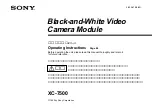
– 61 –
5-1. Troubles and corrective measures (Sewing conditions)
Trouble
Cause
Corrective measures
1. The needle thread
slips off at the
start of bar-tack-
ing.
①
Stitches are slipped at the start.
②
The needle thread remaining on the nee-
dle after thread trimming is too short.
③
The bobbin thread is too short.
④
Needle thread tension at 1st stitch is too
high.
⑤
Stitching pitch at 1st stitch is too small.
◦
Adjust the clearance provided between the nee-
dle and the hook.
◦
Set soft-start sewing at the beginning of sewing.
◦
Decrease the tension of the thread tension con-
troller No. 1.
◦
Increase the tension of the thread take-up spring.
◦
Decrease the bobbin thread tension.
◦
Increase the clearance between the needle and
the counter knife.
◦
Decrease the needle thread tension at 1st stitch,
and extend the duration of the AT operation at the
beginning of sewing.
◦
Make the stitching pitch at 1st stitch longer.
◦
Decrease the needle thread tension at 1st stitch.
2. Thread often
breaks or syn-
thetic fiber thread
splits finely.
①
The hook or the inner hook holder has
scratches.
②
The needle hole guide has scratches.
③
Thread enters the groove in the hook.
④
The needle thread tension is too high.
⑤
The tension of the thread take-up spring
is too high.
⑥
The synthetic fiber thread melts due to
heat generated on the needle.
⑦
When taking up the thread, the needle
tip penetrates the thread.
◦
Remove the hook and grind hook or the inner
hook holder with a fine grind stone or buff them.
◦
Buff the needle hole guide or replace it with a
new one.
◦
Detach the hook to remove the thread.
◦
Decrease the needle thread tension.
◦
Decrease the tension of the thread take-up
spring.
◦
Use the optional needle cooler.
◦
Check the rough state of needle tip.
◦
Use the ball-pointed needle.
3. The needle often
breaks.
①
The needle is bent.
②
The needle comes in contact with the
intermediate presser.
③
The needle is too thin for the material.
④
Clearance between the needle and the
hook is too small.
◦
Replace the bent needle.
◦
Adjust the position of the intermediate presser.
◦
Replace it with a thicker needle according to the
material.
◦
Adjust the clearance between the needle and the
hook.
4. Threads are not
trimmed.
(Bobbin thread
only)
①
The counter knife is dull.
②
Knife pressure of the counter knife is
low.
③
The counter knife has been improperly
positioned.
④
The last stitch is skipped.
⑤
Bobbin thread tension is too low.
⑥
Flopping of cloth
◦
Replace the counter knife.
◦
Adjust the knife pressure of the counter knife.
◦
Correct the position of the counter knife.
◦
Correct the timing between the needle and the
hook.
◦
Increase the bobbin thread tension.
◦
Lower the intermediate presser height.
5. Stitch skipping
often occurs.
①
Clearance provided between the needle
and the hook is not correct.
②
Position of the inner hook holder against
the needle is not correct.
③
The needle is bent.
④
The needle thread after thread trimming
is too long.
◦
Adjust the clearance between the needle and the
hook.
◦
Adjust the position of the inner hook holder
against the needle.
◦
Replace the bent needle.
◦
Decrease the tension of the thread take-up
spring.
◦
Increase the tension of the thread tension control-
ler No. 1.
6. The needle thread
comes out on the
wrong side of the
material.
①
The needle thread tension is not high
enough.
②
The needle thread after thread trimming is
too long.
◦
Increase the needle thread tension.
◦
Increase the tension of the thread tension control-
ler No. 1.
7. Threads break
at time of thread
trimming.
①
The knife has been improperly position.
◦
Correct the position of the knife.



































